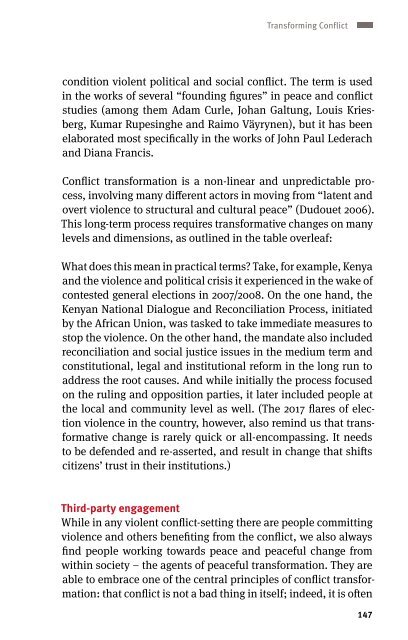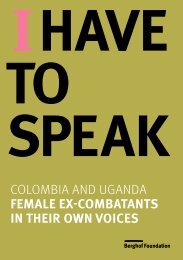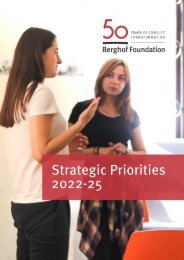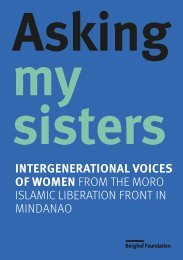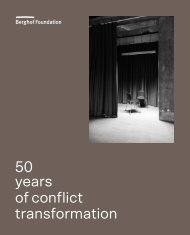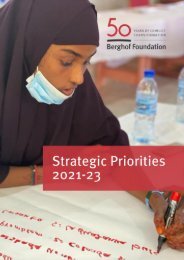Berghof Glossary on Conflict Transformation
The Berghof Glossary on Conflict Transformation presents 20 of the main principles and approaches used by the Berghof Foundation in its work. It is a concise and accessible exploration of what it takes to create “space for conflict transformation”. 2019 edition.
The Berghof Glossary on Conflict Transformation presents 20 of the main principles and approaches used by the Berghof Foundation in its work. It is a concise and accessible exploration of what it takes to create “space for conflict transformation”. 2019 edition.
Create successful ePaper yourself
Turn your PDF publications into a flip-book with our unique Google optimized e-Paper software.
Transforming C<strong>on</strong>flict<br />
c<strong>on</strong>diti<strong>on</strong> violent political and social c<strong>on</strong>flict. The term is used<br />
in the works of several “founding figures” in peace and c<strong>on</strong>flict<br />
studies (am<strong>on</strong>g them Adam Curle, Johan Galtung, Louis Kriesberg,<br />
Kumar Rupesinghe and Raimo Väyrynen), but it has been<br />
elaborated most specifically in the works of John Paul Lederach<br />
and Diana Francis.<br />
C<strong>on</strong>flict transformati<strong>on</strong> is a n<strong>on</strong>-linear and unpredictable process,<br />
involving many different actors in moving from “latent and<br />
overt violence to structural and cultural peace” (Dudouet 2006).<br />
This l<strong>on</strong>g-term process requires transformative changes <strong>on</strong> many<br />
levels and dimensi<strong>on</strong>s, as outlined in the table overleaf:<br />
What does this mean in practical terms? Take, for example, Kenya<br />
and the violence and political crisis it experienced in the wake of<br />
c<strong>on</strong>tested general electi<strong>on</strong>s in 2007/2008. On the <strong>on</strong>e hand, the<br />
Kenyan Nati<strong>on</strong>al Dialogue and Rec<strong>on</strong>ciliati<strong>on</strong> Process, initiated<br />
by the African Uni<strong>on</strong>, was tasked to take immediate measures to<br />
stop the violence. On the other hand, the mandate also included<br />
rec<strong>on</strong>ciliati<strong>on</strong> and social justice issues in the medium term and<br />
c<strong>on</strong>stituti<strong>on</strong>al, legal and instituti<strong>on</strong>al reform in the l<strong>on</strong>g run to<br />
address the root causes. And while initially the process focused<br />
<strong>on</strong> the ruling and oppositi<strong>on</strong> parties, it later included people at<br />
the local and community level as well. (The 2017 flares of electi<strong>on</strong><br />
violence in the country, however, also remind us that transformative<br />
change is rarely quick or all-encompassing. It needs<br />
to be defended and re-asserted, and result in change that shifts<br />
citizens’ trust in their instituti<strong>on</strong>s.)<br />
Third-party engagement<br />
While in any violent c<strong>on</strong>flict-setting there are people committing<br />
violence and others benefiting from the c<strong>on</strong>flict, we also always<br />
find people working towards peace and peaceful change from<br />
within society – the agents of peaceful transformati<strong>on</strong>. They are<br />
able to embrace <strong>on</strong>e of the central principles of c<strong>on</strong>flict transformati<strong>on</strong>:<br />
that c<strong>on</strong>flict is not a bad thing in itself; indeed, it is often<br />
147


